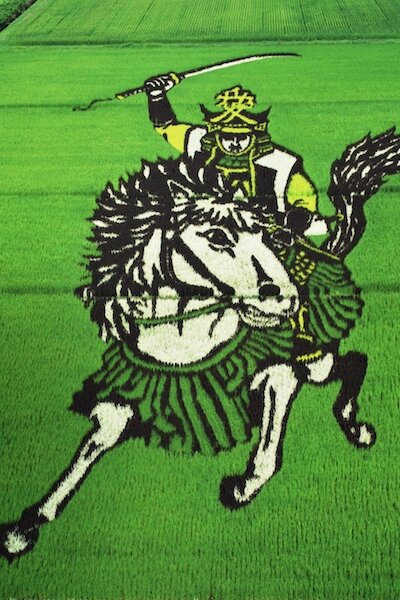The beauty of art is that it exists in many forms and the possibilities are only limited by one’s creativity. The villagers of Inakadate, a nondescript small town located in Aomori prefecture, took creativity to a whole new, spectacular level.

Samurai Warlord Sengoku Busho Rice Field Art. Photo from: Captain76/CC.
In 1993, with the humble rice fields as their inspiration, the villagers came up with an idea to create words and shapes on their rice fields using various types of coloured rice plants. The original purpose was actually to promote "Tsurugaotome rice", a local brand of rice, and to revive the old village. This public art project became a huge success. Better known as Tanbo (meaning rice field) Art, this spark of genius evolved into a world-famous annual rice field art event in Inakadate that attracts lots of tourists every year.
Over the years, they grew more adventurous and produced impressively complicated images of famous figures and Japanese folklore.
How rice field art is created
In painting, different shades form shadows and highlights to make an image come alive. Rice field art employs the same technique, but with rice plants in various colours instead of ink. Aside from the use of shadows and highlights, the making of rice field art also requires designing with an aerial perspective in mind. Then comes the site surveying and actual rice planting. This technique is unique to Japan, and eventually, the makers of Tanbo Art have become so skilled that they are able to replicate the most intricate of designs — even a famous scene in Gone With the Wind.
The rice plants used to create these astounding artworks are a combination of standard varieties used for everyday consumption and ornamental varieties. The colours typically included are green, yellow, deep purple, white, orange, red and more. For more complicated designs, the medley of rice plants used to form the colour palette may include more than 10 varieties. Ultimately, what gets planted and cultivated will be based on the final artwork design. By early summer, the plants mature and the stunning art piece is ready to be appreciated by over 100,000 Japanese and foreign visitors. Here's a tip: the best season to view the rice field art in its full glory is during the months of July and August.



